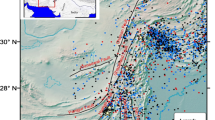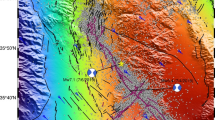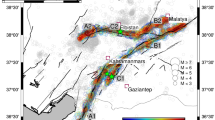Abstract
The b-value is closely related to the crustal stress. By studying the b-value trends of regions before large earthquakes, we can obtain the evolution of crustal stress, which is generally considered useful earthquake precursor information. A quake is closely related to fault tectonic movement. In the past, the traditional b-value calculation method did not consider the spatial distribution of the fault. Here, we propose a new algorithm based on the fault’s buffer area, combining the spatial distribution and trend of the fault. This algorithm can accurately calculate the b-value changes for a specific fault using the fault as the basic independent unit. This method provides a useful reference for earthquake hazard judgment. Based on this algorithm, we use a total of 428,963 earthquakes from 1980 to 2013 after removal of the aftershock sequences and combine these quakes with the active fault distribution data to study the b-value changes before major earthquakes in western Sichuan. The results show that the b-values of the Fubianhe fault, Longmenshan main fault, and Shuangshi–Pengguan fault in western Sichuan decreased for at least 2 years before the earthquakes. The Longmenshan main fault area began to decrease slowly 5 years before the Wenchuan Ms8.0 earthquake and sharply decreased in the year before the quake, which reflects a significant change in crustal stress during this time. This conclusion and the method are available for long-term earthquake hazard assessment as a reference.







Similar content being viewed by others
References
Aki, K. (1965). Maximum likelihood estimate of b in the formula lingN = a-bM and its confidence limits. Bulletin of the Earthquake Research Institute Tokyo University,43, 237–239.
Artikov, T. U., Ibragimov, R. S., Ibragimova, T. L., & Mirzaev, M. A. (2018). Identification of expected seismic activity areas by forecasting complex seismic-mode parameters in Uzbekistan. Geodesy and Geodynamics, 9(2), 121–130.
Chen, G. G., Ji, F. J., Zhou, R. J., et al. (2007). Primary research of activity segmentation of Longmenshan fault zone since Late-Quaternary. Seismology and Geology (in Chinese),29(3), 657–673.
Gutenberg, B., & Richter, C. R. (1954). Magnitude and energy of earthquakes[J]. Ann Geofis,9, 1–15.
Huang, W. Q., & Li, W. X. (1998). Determining the time and space domains for estimating b value in seismic zoning [J]. Acta Seismologica Sinica (English Edition),05, 3–8.
Huang, W. Q., & Wu, X. (2001). Influence of statistical time range on estimating seismicity parameters [J]. Acta Seismologica Sinica,14(6), 626–633.
Huang, Y., Wu, J., Zhang, T., & Zhang, D. (2008). Relocation of the M8.0 Wenchuan earthquake and its aftershock sequence. Science in China Series D: Earth Sciences, 51(12), 1703–1711.
Huang, F., Li, M., Ma, Y., Han, Y., Tian, L., Yan, W., et al. (2017). Studies on earthquake precursors in China: a review for recent 50 years. Geodesy and Geodynamics, 8(1), 1–12.
Liu, Y. B., & Pei, S. P. (2017). Temporal and spatial variation of b-value before and after Wenchuan earthquake and its tectonic implication. Chinese Journal of Geophysics (in Chinese),60(6), 2104–2112. https://doi.org/10.6038/cjg20170607.
Molchan, G. M., Kronrod, T. L., & Nekrasova, A. K. (1999). Immediate foreshocks; time variation of the b-value. Physics of the Earth and Planetary Interiors,111, 229–240.
Mullick, M., & Mukhopadhyay, D. (2017). Quantitative analysis of the Nepal earthquake on 25 April, 2015 in the perspective of future earthquake hazard. Geodesy and Geodynamics, 8(2), 77–83.
Nuannin, P., Kulhánek, O., & Persson, L. (2012). Variations of b-values preceding large earthquakes in the Andaman–Sumatra subduction zone. Journal of Asian Earth Sciences, 61, 237–242.
Oncel, A. O., Main, I. O., & Cowie, P. (1996). Spatial variations of the fractal properties of seismicity in Anatolian fault zone. Tectonophysics,257, 189–202.
Ren, X. M. (2011). Study on the estimation of b value on Seismic Zonation. Beijing: Institute of physics China seismological Bureau.
Sahu, O. P., & Saikia, M. M. (1994). The b-value before the 6th August, 1988 India-Myanmar border region earthquake—a case study. Tectonophysics,234, 349–354.
Scholz, C. H. (1968). The frequency–magnitude relation of microfracturing in rock and its relation to earthquakes. Bulletin of the Seismological Society of America,58, 399–415.
Schorlemmer, D., Wiemer, S., & Wyss, M. (2005). Variations in earthquake-size distribution across different stress regimes. Nature, 437(7058), 539.
Shi, H. X., Meng, L. Y., Zhang, X. M., et al. (2018). Decrease in b value prior to the Wenchuan earthquake (Ms 80). Chinese Journal of Geophysics (in Chinese),61(5), 1874–1882. https://doi.org/10.6038/cjg2018m0024.
Silacheva, N. V., Kulbayeva, U. K., & Kravchenko, N. A. (2018). Probabilistic seismic hazard assessment of Kazakhstan and Almaty city in peak ground accelerations. Geodesy and Geodynamics, 9(2), 131–141.
Wang, J. (2016). A Mechanism Causing b-value anomalies prior to a mainshock [J]. Bulletin of the Seismological Society of America,106, 4.
Yi, G. X., Wen, X. Z., & Su, Y. J. (2008). Study on the potential strong-earthquake risk for the eastern boundary of the Sichuan-Yunnan active faulted-block, China. Chinese Journal of Geophysics (in Chinese),51(6), 1719–1725.
Zhang, S., & Zhou, S. (2016). Spatial and temporal variation of b-values in southwest China. Pure and Applied Geophysics, 173(1), 85–96.
Acknowledgements
This research was supported by funding from the Science for Earthquake Resilience of the China Earthquake Administration (XH17022), the National Key Basic Research Program of China (2013CB733305), the Research Fund of the Institute of Seismology and Institute of Crustal Dynamics, China Earthquake Administration (Grant no. IS20146141) and the National Natural Science Foundation of China (Grant no. 41204014).
Author information
Authors and Affiliations
Corresponding author
Additional information
Publisher's Note
Springer Nature remains neutral with regard to jurisdictional claims in published maps and institutional affiliations.
Rights and permissions
About this article
Cite this article
Zhao, B., Yang, G., Wang, J. et al. Research on b-Values Based on Fault Buffers. Pure Appl. Geophys. 177, 71–80 (2020). https://doi.org/10.1007/s00024-019-02163-x
Received:
Revised:
Accepted:
Published:
Issue Date:
DOI: https://doi.org/10.1007/s00024-019-02163-x




